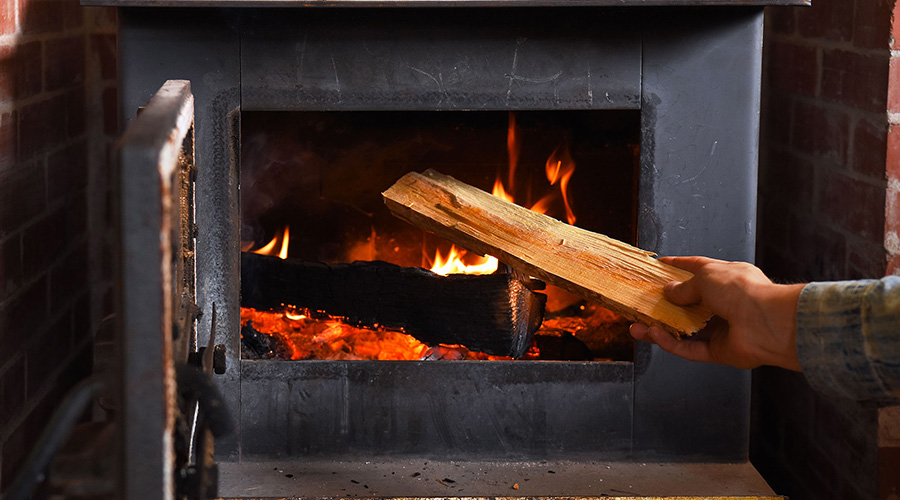In collaboration with Promutuel Insurance
Have a wood-burning appliance in your home or thinking of installing one? Got your heart set on a property with a fireplace or another wood-burning appliance? It’s important to know how to maintain and use such appliances to reduce the risk of fire hazards. We’ve put together a list of everything you need to know to safely enjoy your fireplace.
Fires in Québec
Did you know over 14,000 home fires are reported each year in Québec? And about 7% of them are caused by chimney fires. According to Québec’s Ministère de la Sécurité publique, the province averages 6 chimney fires a day in the cold season from December to April. Moreover, from 2016 to 2018, heating appliances were to blame for 10.7% of building fires with casualties. These statistics are proof of the heightened risks involved in homes with a wood stove or fireplace.
More on wood-burning appliances
From wood stoves and fireplaces inside the home to backyard wood-fired ovens, residential wood-burning appliances come in a variety of shapes and sizes. Here are some things to consider before you buy:
What’s the difference between fireplaces and wood stoves?
Fireplaces are essentially insulated boxes built into a wall with a highly customizable exterior. The flickering flames, crackling wood, and toasty smells that spark visions of cozy nights with the family are all part of their charm. However, they require a great deal of maintenance and can pose a chimney fire risk.
Wood stoves, on the other hand, are stand-alone appliances built on legs or a pedestal. They also require a chimney, which may be easier to fit with a room’s décor, but can be cumbersome and dangerous, especially for young children.
Outdoor wood-burning appliances
A number of wood-burning appliances are designed for backyard use, from wood-burning pizza ovens to outdoor wood stoves, and more. But they too can present a fire hazard, which is why they must be installed and used according to the manufacturer’s instructions.
Before buying a wood-burning appliance
The first thing you have to do before installing a wood-burning appliance is to check your municipality’s by-laws. Make sure the model you want meets Canadian standards with a certification from the Underwriters Laboratory of Canada (ULC) or the Canadian Standards Association (CSA).
How to use a wood-burning appliance
Some precautions must be taken to safely enjoy a wood-burning appliance. After installing your appliance on a non-combustible surface, away from flammable items, you’ll have to safely light and feed the fire by hand.
How to maintain a wood-burning appliance
The biggest drawback of a wood-burning appliance is upkeep. After each use, safely dispose of any wood ash and dust the appliance. For both fireplaces and stoves, it’s also important to regularly remove creosote build-up, clean the interior of the appliance weekly, and have your chimney swept every year after winter.
Fire prevention
Regardless of the type of wood-burning appliance, good prevention practices can help reduce the risk of fire. Here are some tips on how to safely enjoy your wood fireplace or stove:
1- Hire professionals
It’s important to bring in an expert to install your wood-burning appliance and sweep your chimney. The Association des professionnels du chauffage is a great starting point for finding one.
2- Inspect the appliance regularly
To avoid fires caused by a wood-burning appliance, it’s very important to inspect its parts and follow the manufacturer’s maintenance instructions to the letter. When buying a home with an existing fireplace or wood stove, be sure to have it inspected by an expert.
3- Equip your home with smoke detectors and a fire extinguisher
All homes with an indoor fireplace or wood stove must be equipped with carbon monoxide detectors and a portable ABC fire extinguisher. Note that if you have battery-powered smoke detectors, you need to replace the batteries every 6 months, and replace the entire system every 10 years.
4- Inform your insurer
When you install a wood-burning appliance or buy a home that has one, you need to tell your insurer. Home insurance covers the home and the property in it against damage, including fire, but if you neglect to inform your insurer of a heating appliance, such as a fireplace, your claim may be denied in the event of an accident.
To safely enjoy the cold days, trust Promutuel Insurance!
